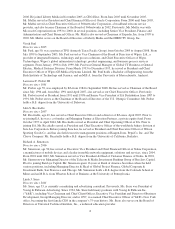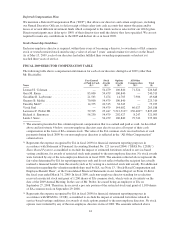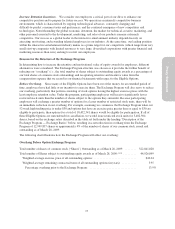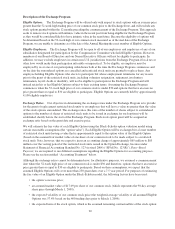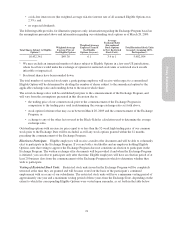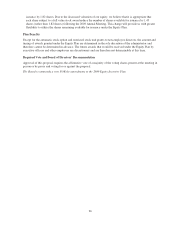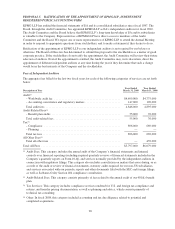Electronic Arts 2009 Annual Report Download - page 26
Download and view the complete annual report
Please find page 26 of the 2009 Electronic Arts annual report below. You can navigate through the pages in the report by either clicking on the pages listed below, or by using the keyword search tool below to find specific information within the annual report.
Overhang After Option Exchange Program(3) (For Illustrative Purposes Only)
Total number of Shares to be cancelled in the Exchange Program (assuming 100%
participation): .................................................................. 18,432,341
Total number of Shares subject to restricted stock units to be issued in exchange for the surrendered
Eligible Options (assuming 100% participation): ....................................... 5,482,504
Total number of Shares subject to outstanding equity awards following the exchange of Eligible
Options for restricted stock units: ................................................... 31,976,262
Weighted-average exercise price of all outstanding options: .............................. $29.63
Weighted-average remaining contractual term of all outstanding options (in years): ........... 5.67
Percentage overhang following the Exchange Program: ............................... 9.9%
1There were 11,085,110 Shares available for grant as of March 28, 2009.
2Includes 34,359,797 outstanding options and 10,566,302 granted but unvested restricted stock and restricted
stock unit awards as of March 28, 2009.
3Assuming options that have an exercise price greater than or equal to $30 are eligible to participate.
The actual reduction in our overhang that could result from the Exchange Program could differ materially from
the example in the chart above and is dependent on a number of factors, including the exercise price at which
outstanding options become eligible to participate in the Exchange Program and the actual level of employee
participation in the program. The reduction in overhang would also be partially offset by the grant of additional
awards under our Equity Plan, including the retention awards described under the heading “Additional Equity
Grants” below.
Recapture Retentive and Incentive Value from Our Compensation Expense. We also believe that the
Exchange Program will allow us to recapture retentive and incentive value from the compensation expense that
we record in our financial statements with respect to certain Eligible Options. We will be able to replace certain
underwater options held by our employees that currently have little retentive and incentive value with a lesser
number of restricted stock units as of the closing date of the Exchange Program (“Exchange Date”), which we
believe will have more motivational value.
Align Equity Incentives with Current Compensation Philosophy. In designing the terms of the Exchange
Program and recommending its approval by the Board of Directors, the Compensation Committee took into account
that since 2005, we have been shifting from the exclusive use of stock options to using a mix of stock options and
other equity-based incentives, such as restricted stock units, to provide long-term equity incentives to our
employees. By granting replacement awards consisting of restricted stock units rather than new, at-the-money stock
options, the Compensation Committee seeks to strengthen our equity-based retention incentives.
Alternatives Considered
In deciding to approve the proposed Exchange Program, we also considered a number of alternatives to the
Exchange Program as a means of incentivizing and retaining employees, including:
Granting Additional Equity Awards.We considered making special grants of restricted stock units and stock
options at current market prices outside of our annual grant practices. However, these additional grants would
substantially increase our overhang and compensation expense, and dilute the interests of our stockholders.
Allowing the Existing Stock Options to Remain Outstanding.We did not believe allowing the significantly
underwater options to remain outstanding would have an appropriately incentivizing effect, because so many of
the stock options held by our employees are significantly out of the money and thus do not provide the same
incentives as those employees who have received options granted more recently with lower exercise prices.
Further, we believed that it could be difficult to retain employees with stock options that are significantly
underwater and that the failure to retain these employees could negatively impact our business. We also
considered that allowing the existing stock options to remain outstanding would not allow us to reduce our
overhang and prevent us from experiencing any retentive and incentive value from the compensation expense
that we record in our financial statements with respect to these significantly underwater options.
18


